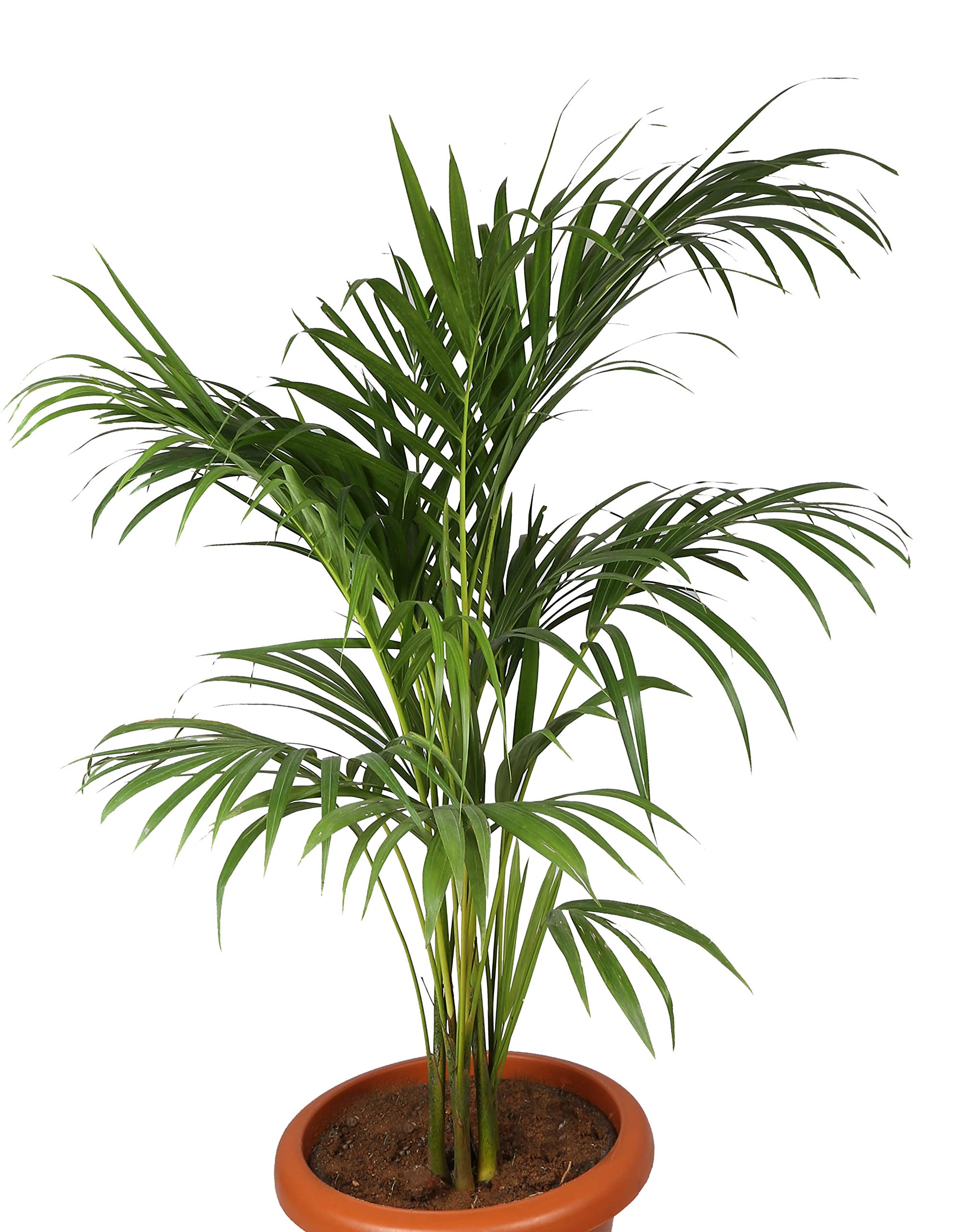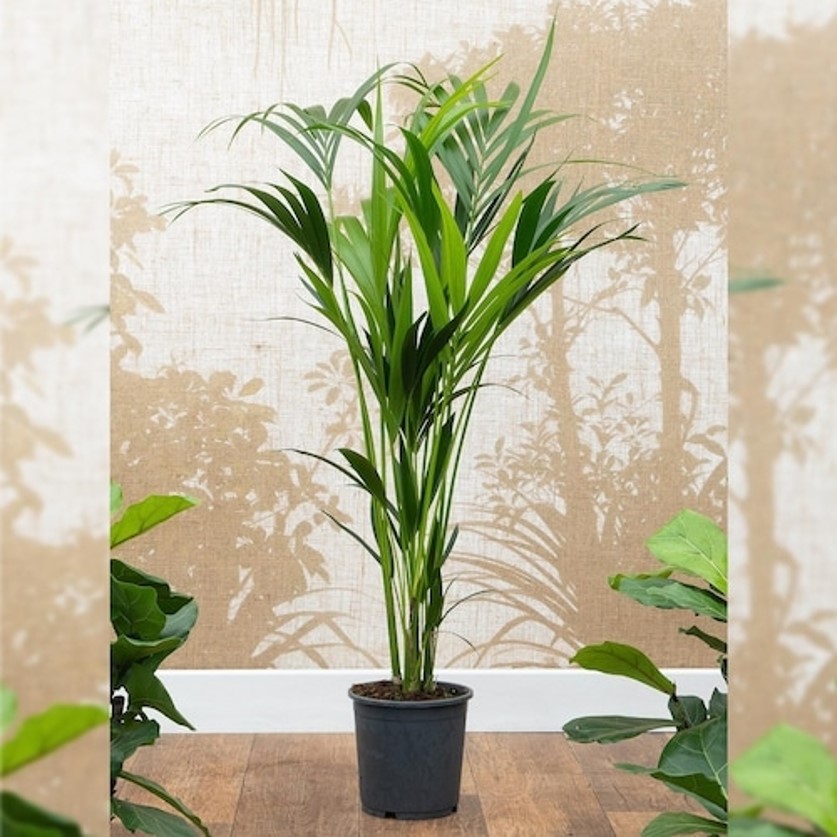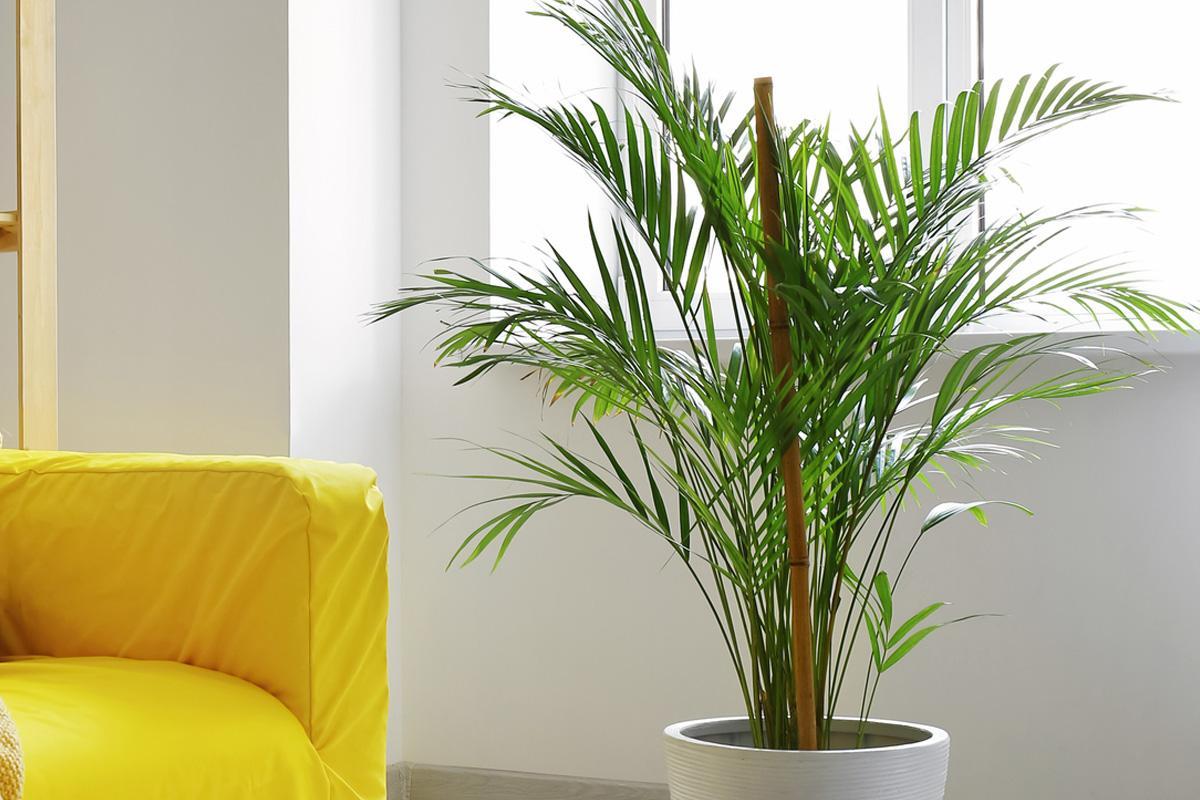A native of Madagascar, the areca palm tree is also known as the butterfly palm, golden cane palm, bamboo palm, or by its scientific name, Dypsis lutescens. These palms have smooth, sometimes golden trunks that look like bunches of bamboo. The fronds resemble bamboo leaves because they are thin and full. Areca palm plants come with a lot of benefits and can be grown both outdoors and indoors. Their growth rate varies from slow to moderate and is best when planted in the spring.
Nothing matches a palm plant for giving your house a tropical feel. They are widely grown indoors since they have a limited outdoor range. If you start looking for them, you’ll start spotting them in interiors everywhere, from workplaces to malls. Bamboo palms are readily available, simple to maintain and even filter air pollutants thanks to their dense leaves.
In this article, we have talked about almost everything you need to know about areca palms in terms of benefits, growth requirements, and propagation. So, if you plan to grow an areca palm or are just curious about this plant, this article is for you.
Contents
- 1 About Areca Palm – An overview
- 2 Benefits of Areca Palms
- 3 Growing Areca Palms
- 4 Caring for Areca Palms
- 5 Watch this video: How to save a dying Areca Palm (5 mins 36 seconds)
- 6 Propagating Areca Palms
- 7 Common Areca Palm problems
- 8 Areca Palms buying recommendations (Enquire here!)
- 8.1 Buds N Blush Areca Palm (Small)
- 8.2 IGP Areca Palm in Jute Wrapping
- 8.3 IKEA Dypsis Lutescens Potted Plant
- 8.4 Nurserylive Areca Palm – Plant
- 8.5 Nurturing Green Areca Palm Plant
- 8.6 The Affordable Organic Store Areca Palm Saplings
- 8.7 Ugaoo Areca Palm Plant XL
- 8.8 Desertcart Areca Palm Plant
- 8.9 WarmOven 32” Areca Palm
- 8.10 Winni Areca Palm Plant
- 9 Beautiful decor ideas with Areca Palm plants (Image gallery)
- 10 Conclusion
- 11 FAQs
- 12 How to grow & care for Snake Plant? (+Decor ideas & buying options)
About Areca Palm – An overview
| Common names | Areca palm, bamboo palm, golden cane palm, yellow palm |
| Botanical name | Dypsis lutescens (formerly Chrysalidocarpus lutescens) |
| Family | Arecaceae |
| Plant type | Palm or cycad |
| Mature size | 12-30 feet tall outdoors with a crown spread of 10-20 feet; 8 feet tall indoors |
| Sun exposure | Full to partial sun |
| Soil type | Moist, well-drained |
| Soil pH | Acidic, neutral |
| Bloom time | Summer |
| Flower colour | Pale yellow |
| Hardiness zones | 10–11 (USDA) |
| Native area | Madagascar |
Benefits of Areca Palms

Image Source: Indoor Gardening
Growing areca palms indoors have a good amount of positive impact on both your physical and mental health. So, here are some of the top benefits of areca palm trees:
Improves air quality
Dry air is a problem if you are someone who uses heaters and air conditioners on a daily basis. Dry air can cause eye itching and skin problems and worsens respiratory ailments. Therefore, to improve the air quality of your home, grow houseplants like areca palms.
Absorb air pollutants
Bamboo palms break down harmful air pollutants like acetone, xylene, formaldehyde, toluene, etc. Hence, it helps in the reduction of indoor pollution and provides pollution-free air to breathe.
| Also see: Jade plant: Benefits, care, propagation & 26+ decor ideas |
Emits more oxygen
Areca palms are one such plant that produces leaves with a large surface area. Hence, these plants produce more oxygen than the ones with small leaves. If you place two bamboo palms in a 100-square-foot area, it can considerably increase the indoor oxygen level.
Decreases stress
Areca palms help in reducing stress and anxiety. According to a recent study, bamboo palms decrease anxiety by 37%, depression by 58%, and fatigue by 38%. Hence, having one indoor areca palm plant benefits productivity and positivity.
A good decor item
Bamboo palm leaves have a delicate texture and stay green all year with little maintenance. You can add a tropical touch to your home decor by adding an areca palm plant to it. The large fronds of bamboo palms also create a bold statement with their huge, fan-like foliage.
| Also see: Decor items for home to accessorize every room |
Growing Areca Palms

Image Source: Trees.com
You can easily grow areca palm trees from seeds. Although the seeds are uncommon in garden supply stores, you can collect them from the fruits that develop after the yellow flowers have bloomed.
- If you’re propagating using seeds, plant them in a seed-starting mixture with a thin layer of soil on top to germinate them at home. In general, the older, orange-coloured seeds germinate more frequently than the more recent, greener seeds.
- With a soil temperature of over 80 degrees Fahrenheit and a moderately high humidity level, germination takes about six weeks.
- As you wait for germination, keep the seed-starting mix moist but not soggy.
- Once germination occurs, keep the seedlings moist as well.
- Plant the seedlings outdoors at a distance of 10 feet once they have a few leaves or for a fuller appearance. You can also place three to four seedlings in a 12-inch container.
| Also see: How to plant, grow & decorate using Jasmine flowers (Shop here!) |
Caring for Areca Palms

Image Source: Primrose
Areca palm trees require minimal care and attention to grow and remain healthy. So, here we have enlisted some of the most important caring tips:
Light
These plants can handle the sun when grown outside, although they prefer bright, filtered light. Areca palm trees can also thrive indoors with exposure to bright light from a south or west-facing window.
Soil
A well-drained, peat-based potting mix is ideal for indoor potted areca palms. The ideal soil for outdoor species is rich, somewhat acidic, and has excellent drainage. To increase soil porosity and reduce pH, it is crucial to amend the soil with sand and peat moss.
Water
Areca palms enjoy moist soil, but they are sensitive to overwatering and cannot stand to be in a potting mix that is waterlogged or saturated. Hence, decrease the amount of moisture in the soil or potting mix between waterings. You can use distilled water or rainwater collection instead of fluoridated water because bamboo palms are also susceptible to it.
Temperature
Areca palm trees thrive in normal temperatures of 65 to 75 degrees Fahrenheit. In areas where the outside temperature doesn’t go below 50 degrees Fahrenheit, it will thrive in outdoor gardens as well. It is recommended to keep indoor plants away from heat sources, air conditioners, and chilly windows when growing them.
Humidity
A high humidity level is necessary to maintain an areca palm’s best appearance. The plant automatically adjusts to the typical indoor humidity level. However, it is normal for the leaf tips to become brown if the air is excessively dry.
Fertilizer
Bamboo palms consume a lot of food from spring to early fall; hence, treating them with a liquid fertilizer is necessary. When the plant is dormant in the late fall and winter, stop fertilizing it.
Potting and repotting
Bamboo palms prefer a slightly congested pot with lots of drainage holes. It’s still best to repot it every other year or so to replace the potting soil and get rid of salt deposits from fertilizers. If the palm’s root ball still fits in the pot without difficulty, use it; if not, go up one container size. The palm should be replanted at the exact same depth as it was planted previously.
Pests and diseases
Pests and diseases don’t pose a severe threat to areca palm trees. Lethal yellowing can occasionally infect a palm. This disease first kills the fronds and eventually the entire plant. Areca palms kept indoors are susceptible to common houseplant pests such as mites, aphids, mealybugs, scales, and whiteflies, which can harm and discolour the leaf. Hence, treating any kind of infestation as soon as possible is advisable.
Watch this video: How to save a dying Areca Palm (5 mins 36 seconds)
Propagating Areca Palms

Image Source: Exoticplants online
Cuttings will not successfully replicate an areca palm; however, root division will result in a lush plant growing more quickly than from seed. Although root division can be done at any time of the year, the spring is when the plant will be at its healthiest. To divide a bamboo palm in a pot through root division:
- Pick a mature plant with numerous stalks.
- The day before dividing, water thoroughly breaks up the soil around the roots.
- Pat the container’s sides to release the root ball, then take the palm out of the pot.
- Remove dirt from the roots so that you can see how the roots correspond to each stem.
- Using a sharp knife, separate four to five stems from the parent plant.
- Using a two-to-one ratio of ordinary potting soil and coarse sand, gently assemble the separated stems in the pot.
- Maintain wet but not saturated soil in the pot and place it in bright but indirect light (avoid direct sunlight).
Common Areca Palm problems
Here are five common problems that can affect Areca palms:
- Irregular watering can be indicated by brown tips. To avoid this, establish a watering schedule that provides consistent moisture to the plant without allowing it to experience prolonged periods of dryness or overwatering.
- If you notice blackening stems, it could be a sign of overwatering. To check for decaying roots, remove the plant from its pot and wash the roots. If the roots are healthy, repot the plant in a well-draining potting mix.
- Brown bumps on leaves can indicate a scale problem. Treating the plant with a fungicide or wiping the leaves with a soap solution can be helpful. Twisted, misshapen leaves suggest that the plant is not getting enough light and should be moved to a brighter location.
- Mealybugs can leave white, cottony deposits on plants, which can be removed by physically cleaning the plant with a soap solution and treating it with neem oil until the problem is resolved.
- Pink stems in plants may indicate rot due to overwatering. Check for root rot and water the plant judiciously. If you notice yellowing leaves in your areca palm, it may be a sign of nitrogen deficiency or low light. Brown spots, on the other hand, may indicate a potassium deficiency.
Areca Palms buying recommendations (Enquire here!)
Buds N Blush Areca Palm (Small)
| E N Q U I R E H E R E |
IGP Areca Palm in Jute Wrapping
| E N Q U I R E H E R E |
IKEA Dypsis Lutescens Potted Plant
| E N Q U I R E H E R E |
Nurserylive Areca Palm – Plant
| E N Q U I R E H E R E |
Nurturing Green Areca Palm Plant
| E N Q U I R E H E R E |
The Affordable Organic Store Areca Palm Saplings
| E N Q U I R E H E R E |
Ugaoo Areca Palm Plant XL
| E N Q U I R E H E R E |
Desertcart Areca Palm Plant
| E N Q U I R E H E R E |
WarmOven 32” Areca Palm
| E N Q U I R E H E R E |
Winni Areca Palm Plant
| E N Q U I R E H E R E |
Beautiful decor ideas with Areca Palm plants (Image gallery)
-
Image Source: Petal Republic
-
Image Source: Tendercare Nurseries
-
Image Source: Petal Republic
-
Image Source: Abana Homes
-
Image Source: Gardener’s Path
-
Image Source: Onehowto.com
-
Image Source: Plant Drop
-
Image Source: Gardener’s Path
-
Image Source: FNP
-
Image Source: Two Peas In A Condo
Conclusion
Areca palm is one of the most widely used indoor plants for various benefits. It’s crucial to pick a planting location with sufficient drainage for bamboo palms cultivated outside. A palm’s roots can decay quickly in wet soil. A container with good drainage is necessary when growing plants inside.
You need to plan to water your bamboo palm on a regular basis to prevent the soil from drying out. During hot and dry weather, it’s particularly crucial to keep outdoor palms hydrated to maintain their health. Palms kept indoors frequently don’t get enough light unless they’re situated close to a really bright window. So bringing your palm outside in warm weather so it may be exposed to sunlight proves beneficial.
Bamboo palms should be fed well during the growing season. There is not much pruning or trimming required for these palms. Any dying fronds should be left until they are primarily brown because they can still contribute to photosynthesis.
Now, you know all about areca palms and their benefits, growth, and caring techniques required to maintain their health. So, create a healthy atmosphere and bring home an areca palm from our top shopping recommendations.
FAQs
How to grow Areca Palm from seed?
To grow Areca palm from seed, start by soaking the seeds in warm water for 24 hours. Fill a pot with a well-draining soil mix and sow the seeds, covering them with a thin layer of soil. Water the pot and cover it with plastic to maintain humidity. Place the pot in a warm, bright location, and keep the soil moist but not waterlogged. Germination can take up to 2-3 months. Once the seedlings are established, transplant them into individual pots with well-draining soil.
How fast does Areca Palm grow?
Areca palm is a relatively fast-growing plant, with an average growth rate of around 6 to 10 inches per year. However, the growth rate can vary depending on the plant’s growing conditions, such as light, temperature, and soil moisture. With proper care, it can reach a height of 6 to 10 feet within a few years.
Can Areca Palm grow indoors?
Yes, Areca palm is a popular indoor plant due to its adaptability to low-light environments and its ability to purify the air. It requires bright, indirect light and consistent watering to thrive indoors. With proper care, it can be a beautiful and healthy addition to any indoor space.
| Also see: Indoor plants designing guide (+41 shopping options) |
Where to grow Areca Palm?
Areca palm is a tropical plant that thrives in warm, humid environments with plenty of bright, indirect light. It can be grown outdoors in areas with mild climates or indoors in pots in areas with cooler temperatures. When growing Areca palm, it’s important to provide well-draining soil, consistent watering, and regular fertilization to promote healthy growth. It’s also important to protect the plant from cold drafts and direct sunlight.
Does Areca Palm need big pots?
Areca palm does not require very large pots, but it does need adequate space for its root system to spread out. A pot that is 1 to 2 inches larger in diameter than the root ball of the plant is usually sufficient. However, it is important to ensure that the pot has drainage holes and that the soil is well-draining to prevent waterlogging.
| Also see: 21 Affordable large planter & pot designs you must buy online! |
Do pots for Areca Palm need drainage holes?
Yes, pots for Areca palm need drainage holes to allow excess water to escape and prevent waterlogging. It requires well-draining soil, and without drainage holes, excess water can accumulate in the pot and lead to root rot. It is important to ensure that the pot has adequate drainage before planting the Areca palm.
*The featured image used in this article is from Flower Council of Holland
How to grow & care for Snake Plant? (+Decor ideas & buying options)
A Snake plant is a common household plant that belongs to the family of Asparagaceae. Its distinctive feature is its sword-li















































